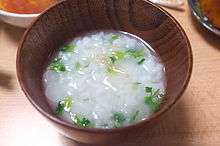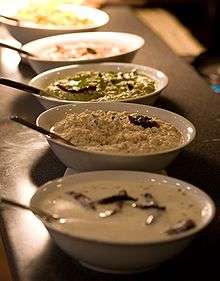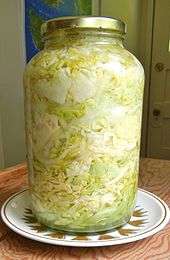List of ancient dishes
This is a list of ancient dishes, foods and beverages that have been recorded as originating during ancient history. The span of recorded history is roughly 5,000 years, beginning with Sumerian Cuneiform script, the oldest discovered form of coherent writing from the protoliterate period around the 30th century BC.[1]
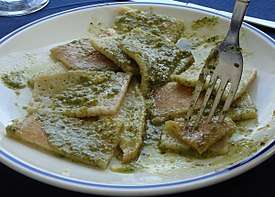
Ancient history can be defined as occurring from the beginning of recorded human history to:
- The Early Middle Ages (the end of the 4th century AD)
- The fall of the Western Roman Empire in 476 AD[2][3]
- The Postclassical Era (200–600 AD and 1200–1500 AD, depending on the continent)[4][5][6][7]
Although the end date of ancient history is disputed, some Western scholars use the fall of the Western Roman Empire in 476 AD (the most used),[8][9] the closure of the Platonic Academy in 529 AD,[10] the death of the emperor Justinian I in 565 AD,[11] the birth of Islam in 610 CE[12] or the rise of Charlemagne[13] as the end of ancient and Classical European history. This list does not contain entries that originated after ancient history.
Archeologists and food historians have recreated some dishes using ancient recipes.[14]
Beginning of recorded history to 476 AD
This section is limited to dishes that originated during the time of ancient history (the beginning of recorded human history) up to the Fall of the Western Roman Empire in 476 AD.
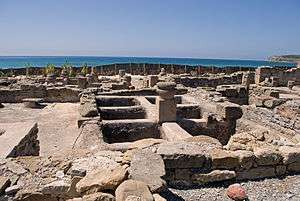
.jpg)
- Anfu ham is a dry-cured ham from Anfu, Jiangxi, China that originated from the Qin Dynasty.[16] It is eaten alone and also used as an ingredient to add flavor to various dishes.[16]
- Ashishim – Israeli red lentil pancake dish of Ancient Israelite origin, that was commonly eaten by Jews in antiquity.
- Babaofan or Eight Treasure Glutinous Rice was first created for a banquet celebrating King Wu of Zhou's defeat of the last King of the Shang Dynasty King Zhou of Shang in the Battle of Muye (circa 1123 BCE according to this article but 1046 BCE according to English Wikipedia article).[17]
- Bread[18][19][20]
- Chutney[25]
- Congee[26]
- Curry[27]
- Doubanjiang – oral history suggests 536 BCE – 448 BCE; first recorded history found in a text from the Western Han Dynasty (206 BCE – 9 CE)[28]
- Fish sauce, see garum
- Forcemeat[29]
- Garum – ancient Greece (where it was known as γάρος) and the Roman Empire, known from before Pompeii's destruction in 79 AD.[30][31]
- Ham – dry-cured ham has been produced since ancient times.[32][33][34]
- Hardtack – versions using various grains date back to ancient Rome, and as far back as ancient Egypt.[35]
- Harissa – an Arab staple dish known to go back at least to the original Caliphates, and most likely earlier.[36]
- Jeok
- Jusselle[37]
- Liquamen, see garum
- Lucanica – Western Roman Empire, mentioned by Cicero, 1st century BC[38][39]
- Maccu[40]
- Misu karu or Misugaru[41]
- Moretum[42]
- Nettle stew
- Nian gao[43]
- Noodles – existent since at least 2,000 BC in Northwest China,[44][45] the noodle was developed independently in ancient China and ancient Rome, and remained common in both areas "through the centuries".[46]
- Oatcake – known to exist at least from Roman times in Britain.[47]
- Olive, olive oil is at least known from the Eastern Mediterranean in the Bronze Age, c. 3000 BC[48][49]
- Oxygala – a dairy product in ancient Greece and Rome.[50] It was also consumed by ancient Persians.[51]
- Papadzules – a common dish in Maya cuisine that may be "one of the most ancient traditional dishes of Yucatán, Mexico.[15]
- Placenta cake – a layered cake of pastry, cheese and honey originating in ancient Greece and Rome[52][53]
- Rice[54] – existed, but was "little-used in the ancient world" outside of Asia.[55]
- Sauerkraut[56]
- Sausage[lower-alpha 1][58]
- Scrapple – originally called "panhas", of ancient Germanic origin.[59][60]
- Sop[61]
- Soup[lower-alpha 2]
- Soy Sauce[66]
- Tamale[67]
- Testaroli[68][69]
- Tharida[70]
- Tofu[71]
- Torta de gazpacho
- Tracta was a kind of bread, pastry, or pancake in ancient Greece and perhaps Rome.[72]
- Wonton[73]
- Zongzi[74]
- Ancient dishes
.jpg)
Beverages
- Beer is recorded in the written history of Mesopotamia and ancient Egypt and is one of the world's oldest prepared beverages.[75]
- Kykeon – a common beverage of sustenance in ancient Greece, most often consisting mainly of a barley gruel mixture with various additives, sometimes written as having psychoactive properties associated with religious visions.[76]
- Kombucha originated in what is now Manchuria around 220 BCE, and is said to have been imported to Japan around 400 CE by the physician Kombu.[77][78]
- Soy milk has been consumed in China since ancient times.[79]
- Wine consumption and production has been found through archaeological evidence as early as c. 6000 BC.[80][81]
Dairy products
- Butter – documented as existent since at least 2,000 BC[82]
- Buttermilk – existed Anno Domini in India[50]
- Kumis – documented as existing in ancient Scythia[50]
- Milk[83]
- Opus lactarium – documented as existing during the ancient Roman Empire[50]
- Quark (lac concretum) – documented as existing in ancient Scythia[50]
- Schiston – "separated milk" purported to have been invented by physicians during the time of the Ancient Roman Empire and Pliny the Elder[50][84] It was prepared by boiling milk or whey along with pebbles.[84][85]
- Shrikhand – documented as existing circa 800 to 300 B.C. in ancient India[50]
- Smy – thickened milk[lower-alpha 3] documented as existent in ancient Egypt[50]
- Yogurt[87] – documented as existing in India circa 300 BC to 75 AD; referred to as "dahi"[50]
Cheeses
- Cheese[lower-alpha 4][89]
- Brânză– an ancient Romanian cheese dating to "before the time of the Romans"[90]
- Caciocavallo
- Cantal – one of the oldest French cheeses, it is named after the Cantal mountain range[91]
- Castelmagno[92]
- Feta – existed during the times of Homer in ancient Greece[94]
- Touloumotiri is an ancient cheese that is considered as the "forerunner to feta".[95]
- Kefalotyri – dates to the Byzantine Empire[96]
- Pecorino Romano – is one of the world's most ancient cheeses[97][98]
- Pecorino Sardo (Flore sardo) – one of the world's oldest cheeses that is believed to date back to the Bronze Age[99]
- Pecorino Siciliano[100]
- Roquefort[101][102][103]
- Tomme[104]
- Ancient cheeses



AD 477–1500
This section includes dishes, foods and beverages that originated during the time of ancient history from 477 AD to 1500 AD (prior to the Postclassical Era).
- Börek – known from 14th century Persia in a poem by Bushaq-i-Atima, although it may be far older.[106][107]
- Hummus – first mentioned in a cookbook from Cairo, Egypt from the 13th century.
- Kuluban – an ancient Javanese dish of boiled vegetables served in spices, similar to modern-day urap. Mentioned in the Rukam inscription, dated to 829 Saka (907 CE) and originating from the Mataram Kingdom.[108]
- Lalab – a similar vegetable dish called rumwah-rumwah was mentioned in the Panggumulan (Kembang Arum) inscription, dated to 824 Saka (902 CE) and originating from the Mataram Kingdom.[109]
- Rawon – a meat stew, called rarawwan in an ancient Javanese Taji inscription (901 CE).[110]
- Rujak – a spicy fruit dish, called rurujak in an ancient Javanese Taji inscription (901 CE).[110]
- Krupuk – a traditional cracker made from rice flour, called kurupuk in ancient Javanese Taji inscription (901 CE).[110]
- Popcorn – an ancient food used by people of the Inca civilization.[111] The food is still commonly used in both regions.[111]
- Philippine adobo – a dish and cooking process originating during the pre-colonial Philippines.[112]
- Tapuy – rice wine originating from the pre-colonial Philippines.[112]
- Tempeh – high-protein fermented soy product from Indonesia. First known as kadêlê, and mentioned in an old Javanese manuscript Serat Sri Tanjung dating to the 12th to 13th century CE.
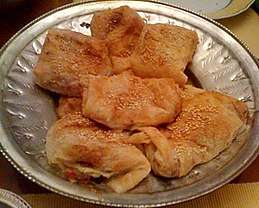
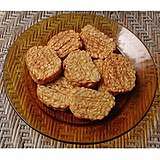 Fried tempeh
Fried tempeh
Lacking time frame
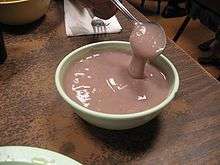
- Khanom chan – an ancient Thai dessert
- Poi – an ancient Polynesian staple food prepared using taro root.[lower-alpha 5]
Likely ancient in origin

- Nattō – prepared using fermented soybeans, nattō has been described as likely being an ancient food.[114] Its origins have been described as unknown,[114] and it may have been developed independently in different areas that have the same ingredients, such as Japan, China, and Korea.[114]
- Abgoosht – also referred to as Dizi or Mesopotamian Meat Stew, was a stew originally made up of remnants of leftover vegetables and meats, different areas in the world have now spun this dish into numerous different variations – including, Armenia, Iran, Azerbaijan, Afghanistan, Pakistan, India, Georgia, Iraq, Lebanon, Syria, Turkey, Russia, Bulgaria, Romania, Hungary – the dish and its origins, however, come from ancient Mesopotamia and the recipe can be dated as far back as at the very least 400 BC as it was mentioned on Cuneiform Tablets during the Babylonian period.[14] Abgoosht and its variants with localised recipes are the national dishes of a number of countries worldwide.
See also
- Amurca
- History of cheese – the history of cheese predates recorded history
- Neolithic founder crops – eight plant species that were domesticated by early Holocene farming communities in the Fertile Crescent region of southwest Asia, and which formed the basis of systematic agriculture in the Middle East, North Africa, India, Persia and (later) Europe
- Old World wine
- Popina – an ancient Roman wine bar, where a limited menu of simple foods (olives, bread, stews) and selection of wines of varying quality were available
- Timeline of food
Ancient cuisines
- Ancient Egyptian cuisine
- Ancient Greek cuisine
- Ancient Israelite cuisine
- Ancient Roman cuisine
- Egyptian cuisine
- Maya cuisine
- Muisca cuisine
List articles
Notes
- "The origin of sausage goes back to ancient times."[57]
- "An ancient food, soup is prepared by cooking meat, fish or vegetables and the like in such fluids as water or milk; it is then consumed as a liquid."[62]
- "Smy, or thickened milk, both human and animal, is often mentioned in medical prescriptions."[86]
- "Cheese is represented in the tomb art of ancient Egypt and in Greek literature"[88]
- "In the Pacific Islands, poi, made from taro root, is an ancient food that is preserved through fermentation."[113]
References
- see Jemdet Nasr period, Kish tablet; see also The Origin and Development of the Cuneiform System of Writing, Samuel Noah Kramer, Thirty Nine Firsts In Recorded History, pp 381-383
- "ancient history". Collins English Dictionary. Retrieved 19 May 2016.
- "ancient history". Oxford English Dictionary. Retrieved 19 May 2016.
- Raymond, T.; Brew, H.S. (2014). Seventh Grade Social Science: For Homeschool or Extra Practice. Golgotha Press. p. pt38. ISBN 978-1-62917-337-5. Retrieved May 19, 2016.
- Harmon, J. (2013). AP World History Crash Course. Research & Education Association. p. 262. ISBN 978-0-7386-6964-9. Retrieved May 19, 2016.
- Colish, M.L. (1990). The Stoic Tradition from Antiquity to the Early Middle Ages: Stoicism in Christian Latin Thought Through the Sixth Century. Studies in the history of Christian thought. BRILL. p. 353. ISBN 978-90-04-09330-0. Retrieved May 19, 2016.
- Bedell, J.M. (2015). So, You Want to Work with the Ancient and Recent Dead?: Unearthing Careers from Paleontology to Forensic Science. Be What You Want. Aladdin/Beyond Words. p. pt22. ISBN 978-1-4814-3846-9. Retrieved May 19, 2016.
- Clare, I. S. (1906). Library of universal history: containing a record of the human race from the earliest historical period to the present time; embracing a general survey of the progress of mankind in national and social life, civil government, religion, literature, science and art. New York: Union Book. Page 1519 (cf., Ancient history, as we have already seen, ended with the fall of the Western Roman Empire; [...])
- United Center for Research and Training in History. (1973). Bulgarian historical review. Sofia: Pub. House of the Bulgarian Academy of Sciences]. Page 43. (cf. ... in the history of Europe, which marks both the end of ancient history and the beginning of the Middle Ages, is the fall of the Western Roman Empire.)
- Hadas, Moses (1950). A History of Greek Literature. Columbia University Press. p. 273. ISBN 978-0-231-01767-1.
- Robinson, C. A. (1951). Ancient history from prehistoric times to the death of Justinian. New York: Macmillan.
- Breasted, J. H. (1916). Ancient times, a history of the early world: an introduction to the study of ancient history and the career of early man. Boston: Ginn and Company.
- Myers, P. V. N. (1916). Ancient History. New York [etc.]: Ginn and company.
- Winchester, Ashley. "The world's oldest-known recipes decoded". www.bbc.com. Retrieved 2020-06-17.
- Sterling, D. (2014). Yucatรกn: Recipes from a Culinary Expedition. The William and Bettye Nowlin Series in Art, History, and Culture of the Western Hemisphere. University of Texas Press. p. 280. ISBN 978-0-292-73581-1. Retrieved May 20, 2016.
- Isacs, John H. (January 16, 2014). "How to match dry-cured swine with perfect wine". Shanghai Daily. Retrieved 21 May 2017.
- "Běi jīng bā bǎo fàn" 北京八宝饭 [Beijing Eight Treasure Glutinous Rice]. Baidu Baike (in Chinese). Retrieved 2018-04-27.
八宝饭,相传源于武王伐纣的庆功宴会。" and "公元前1123 年,周武王率诸侯东征,败纣于今河南省洪县南的牧野。纣0死,武王及定天下,建都于镐,即今长安西上林苑中。在周武王伐纣,建立天下的大业中,伯达、伯适、仲突、仲忽、叔夜、叔夏、季随、季骗八士,功勋赫赫,深为武王和人民称誉。在武王伐纣的庆功宴会上,天下欢腾,将士雀跃,庖人应景而作八宝饭庆贺。
- Flux, P. (2001). Ancient Egypt. Explore history. Pearson Education. p. 12. ISBN 978-0-435-33854-1. Retrieved May 19, 2016.
- Kaufman, C.K. (2006). Cooking in Ancient Civilizations. Daily Life Through History. Greenwood Press. p. 87. ISBN 978-0-313-33204-3. Retrieved May 19, 2016.
- Nicholson, P.T.; Shaw, I. (2000). Ancient Egyptian Materials and Technology. Cambridge University Press. p. 564. ISBN 978-0-521-45257-1. Retrieved May 19, 2016.
- Kraig, B.; Sen, C.T. (2013). Street Food Around the World: An Encyclopedia of Food and Culture. ABC-CLIO. p. 207. ISBN 978-1-59884-955-4. Retrieved May 19, 2016.
- Griffith, J.B. (2013). Knead It!: 35 Great Bread Recipes to Make at Home Today. i-5 Publishing LLC. p. 100. ISBN 978-1-62008-054-2. Retrieved May 19, 2016.
- Raichlen, S.; Fink, B. (2008). The Barbecue! Bible. Workman Pub. p. 128. ISBN 978-0-7611-4944-6. Retrieved May 19, 2016.
- Jina (2006-05-24). "Mán tóu dí lì shǐ" 馒头的历史 [History of Mantou]. 中国国学网 (in Chinese).
《事物绀珠》说,相传"秦昭王作蒸饼"。
CS1 maint: uses authors parameter (link) - Aggarwal, U. (2016). Incredible Taste of Indian Vegetarian Cuisine. First Edition. Allied Publishers Pvt. Limited. p. 200. ISBN 978-93-85926-02-0. Retrieved May 19, 2016.
- Huang, H.T. (2000). Fermentations and Food Science. Biology and biological technology. Cambridge University Press. p. 88. ISBN 978-0-521-65270-4. Retrieved May 19, 2016.
- DeWitt, D. (2014). Precious Cargo: How Foods From the Americas Changed The World. Counterpoint LLC. p. 281. ISBN 978-1-61902-388-8. Retrieved May 19, 2016.
- "Dòu bàn jiàng" 豆瓣醬 [Doubanjiang or Salty Bean Paste]. Baidu Baike (in Chinese).
民间传说:酱是范蠡在无意中创制而成。" and "西汉元帝时代的史游在《急就篇》中就记载有:“芜荑盐豉醯酢酱”。
- Hurt, J.; King, J. (2012). The Complete Idiot's Guide to Sausage Making. The Complete Idiot's Guide. DK Publishing. p. pt27. ISBN 978-1-101-57224-5. Retrieved May 19, 2016.
- Dalby, A. (2013). Food in the Ancient World from A to Z. The Ancient World from A to Z. Taylor & Francis. p. 156. ISBN 978-1-135-95422-2. Retrieved May 19, 2016.
- Pliny the Elder, Natural History 13.93. (Before 79 AD)
- V. M. Balasubramaniam, G.V.B.C.H.L.M.L. (2016). High Pressure Processing of Food. Food Engineering Series. Springer. p. 598. ISBN 978-1-4939-3234-4. Retrieved May 19, 2016.
- Dalby, A. (2013). Food in the Ancient World from A to Z. The Ancient World from A to Z. Taylor & Francis. p. 269. ISBN 978-1-135-95422-2. Retrieved May 19, 2016.
- Hui, Y.H.; Meunier-Goddik, L.; Josephsen, J.; Nip, W.K.; Stanfield, P.S. (2004). Handbook of Food and Beverage Fermentation Technology. Food Science and Technology (Marcel Dekker), Vol 134. Taylor & Francis. p. 427. ISBN 978-0-8247-5122-7. Retrieved May 19, 2016.
- "Education Resource Portal: Hardtack". mnhs.org. Minnesota Historical Society. Retrieved June 11, 2020.
- "The Art and Beauty of Hrissé". 365daysoflebanon. Karenkaram. Retrieved June 18, 2020.
- The Literary Gazette and Journal of the Belles Lettres, Arts, Sciences, &c. W.A. Scripps. 1843. p. 823. Retrieved May 18, 2016.
- Jenkins, N.H. (2007). Cucina del Sole: A Celebration of Southern Italian Cooking. HarperCollins. p. 16. ISBN 978-0-06-072343-9. Retrieved May 19, 2016.
- Riley, G. (2007). The Oxford Companion to Italian Food. Oxford Companion To... Series. Oxford University Press, USA. p. 327. ISBN 978-0-19-860617-8. Retrieved May 19, 2016.
- Helstosky, Carol (2009). Food Culture in the Mediterranean. Greenwood Publishing Group. p. 7. ISBN 978-0313346262.
- Kiple, K.F. (2000). The Cambridge world history of food. 2 (2000). The Cambridge world history of food. Cambridge University Press. p. 1186. ISBN 978-0-521-40215-6. Retrieved May 19, 2016.
- Dalby, A. (2013). Food in the Ancient World from A to Z. The Ancient World from A to Z. Taylor & Francis. p. 222. ISBN 978-1-135-95422-2. Retrieved May 19, 2016.
- "Nián gāo or Rice Cakes" 年糕 [Nian gao (Rice Cakes)]. Baidu Baike (in Chinese). Retrieved 2018-04-26.
原来是当年伍子胥在姑苏城督造城墙时,已做好了屯粮防饥的准备。" and "汉朝对米糕就有“稻饼”、“饵”、“糍”等多种称呼。汉代扬雄的《方言》一书中就已有“糕”的称谓,魏晋南北朝时已流行。" (trans summary – Wu Zixu in the construction of the city walls hid Nian gao underneath the foundation; upon his death he told the starving city residents to dig out the Nian gao for food. This happened circa 484 BCE. Also rice cakes were known by several different names during the Han Dynasty (206 BCE – 220 CE) including dào bǐng, ěr, cí, etc. In a book on Chinese Dialects written during the Han Dynasty there appears the word "gāo"....
- Leslie Bilderback, CMB (2007). The Complete Idiot's Guide To Comfort Food. THE COMPLETE IDIOT'S GUIDE. DK Publishing. p. 167. ISBN 978-1-4406-2617-3. Retrieved May 19, 2016.
- Waxman, M.B. (2008). Eat Me Now!: Healthy Macrobiotic Cooking for Students and Busy People. PublishAmerica. p. pt150. ISBN 978-1-4560-4528-9. Retrieved May 19, 2016.
- Coyle, L. Patrick (1982). The world encyclopedia of food. Facts on File. p. 427. ISBN 9780871964175. Retrieved 20 May 2016.
- "History of the Oatcake". mckenzie-biscuits.com. Mckenzies. Retrieved June 11, 2020.
- Whitehouse, R. (2016). Liguria. Bradt Travel Guides Liguria. Bradt Travel Guides. p. 34. ISBN 978-1-78477-010-5. Retrieved May 19, 2016.
- Harper, D.; Faccioli, P. (2010). The Italian Way: Food and Social Life. University of Chicago Press. p. 153. ISBN 978-0-226-31726-7. Retrieved May 20, 2016.
- Kurmann, Joseph A.; Rasic, J.L.; Kroger, M. (1992). Encyclopedia of Fermented Fresh Milk Products: An International Inventory of Fermented Milk, Cream, Buttermilk, Whey, and Related Products. An Avi book. Springer. p. 352. ISBN 978-0-442-00869-7. Retrieved May 19, 2016.
- Dalby, A. (2003). Food in the Ancient World from A to Z. Ancient world from A to Z. Routledge. p. 218. ISBN 978-0-415-23259-3. Retrieved May 19, 2016.
- "American Pie". American Heritage. April–May 2006. Archived from the original on 2009-07-12. Retrieved 2009-07-04.
The Romans refined the recipe, developing a delicacy known as placenta, a sheet of fine flour topped with cheese and honey and flavored with bay leaves.
- Faas, Patrick (2005). Around the Roman Table. University of Chicago Press. pp. 184–185. ISBN 978-0226233475.
- Proctor, H.B. (1882). Rice: its history, culture, manufacture, and food value. William Dunham. p. 9. Retrieved May 19, 2016.
- Alcock, J.P. (2006). Food in the Ancient World. Food through history. Greenwood Press. pp. 34–35. ISBN 978-0-313-33003-2. Retrieved May 19, 2016.
- Snyder, M.; Faass, N. (2009). The Everything Raw Food Recipe Book. Everything®. F+W Media. p. 295. ISBN 978-1-4405-2102-7. Retrieved May 19, 2016.
- "History of the Dry Sausage Business". Volume 61. The National Provisioner. November 29, 1919. p. 19. Retrieved 18 May 2016.
- America, United Master Butchers of (1915). American Meat Trade and Retail Butchers Journal. Wm. H. Hornidge. p. 217. Retrieved May 19, 2016.
- "Pennsylvania Dutch Food". Encyclopedia.com. Retrieved June 7, 2020.
- "Lancaster County comfort food: Scrapple is a beloved mystery ..." lancasteronline.com. Retrieved June 7, 2020.
- Schwartz, A. (1994). Soup Suppers: More Than 100 Main-Course Soups and 40 Accompaniments. HarperCollins. p. 12. ISBN 978-0-06-096948-6. Retrieved May 18, 2016.
- Coyle, L.P. (1982). The world encyclopedia of food. Facts on File. ISBN 978-0-87196-417-5. Retrieved May 19, 2016.
- Nasello, Sarah (January 10, 2015). "Try Acquacotta soup as a new recipe for the new year". The Jamestown Sun. Retrieved April 29, 2016.
- Flacelière, Robert (1965). Daily Life in Greece at the Time of Pericles. Macmillan. p. 170.
- Dunster, Edward Swift; Foster, Frank Pierce; Hunter, James Bradbridge; Sajous, Charles Eucharist de Medicis; Klaunberg, Henry J.; Stragnell, Gregory; Martí-Ibáñez, Félix (1 January 1917). "International Record of Medicine and General Practice Clinics". MD Publications – via Google Books.
- Shurtleff, William; Aoyagi, Akiko. History of Soy Sauce (160 CE to 2012):Extensively Annotated Bibliography and Sourcebook (PDF). p. 6.
- Planet, L.; Staff, Lonely Planet Publications (2012). The World's Best Street Food: Where to Find It and How to Make It. Lonely Planet Publications. p. 165. ISBN 978-1-74321-664-4. Retrieved May 19, 2016.
- White, A.; Varney, J. (2012). Philadelphia Chef's Table: Extraordinary Recipes from the City of Brotherly Love. Chef's Table. Lyons Press. p. 94. ISBN 978-0-7627-8944-3.
- Pyenson, Luke (July 30, 2013). "Genovese pesto 'pancake'? Perfetto!". The Boston Globe. Retrieved March 5, 2016. (subscription required)
- Davidson, A.; Jaine, T. (2014). The Oxford Companion to Food. Oxford Companions. OUP Oxford. p. 818. ISBN 978-0-19-104072-6. Retrieved May 19, 2016. (subscription required)
- Nguyen, A.; Caruso, M. (2012). Asian Tofu: Discover the Best, Make Your Own, and Cook It at Home. Ten Speed Press. p. 1. ISBN 978-1-60774-025-4. Retrieved May 19, 2016.
- Dalby, Andrew, Food in the Ancient World from A to Z, ISBN 1-135-95422-4, 'Pastry', p. 251
- 馄饨 [Wonton]. Baidu百科 (in Chinese). Retrieved 2018-02-21.
(English summary – A dish created by Xishi, a renowned beauty for King Fuchai (528 BCE – 478 BCE) of the Wu Kingdom during the Autumn-Spring historical period.)
- "Backgrounder:Origins of Zongzi". Sina 新浪 English.
- "Beer". Britannica.com.; Michael M. Homan, Beer and Its Drinkers: An Ancient near Eastern Love Story, Near Eastern Archaeology, Vol. 67, No. 2 (Jun. 2004), pp. 84–95.
- "Kykeon- Definition". Ancient History Encyclopedia. Joshua J. Mark. Retrieved June 18, 2020.
- Jayabalan, R., Malbaša, R. V., Lončar, E. S., Vitas, J. S. and Sathishkumar, M. (2014). "A Review on Kombucha Tea—Microbiology, Composition, Fermentation, Beneficial Effects, Toxicity, and Tea Fungus". Comprehensive Reviews in Food Science and Food Safety. 13 (4): 538–550. doi:10.1111/1541-4337.12073.
Fermentation of sugared tea with a symbiotic culture of acetic acid bacteria and yeast (tea fungus) yields kombucha tea which is consumed worldwide for its refreshing and beneficial properties on human health. Important progress has been made in the past decade concerning research findings on kombucha tea and reports claiming that drinking kombucha can prevent various types of cancer and cardiovascular diseases, promote liver functions, and stimulate the immune system.
CS1 maint: multiple names: authors list (link) - Tietze, H. (1996). Kombucha: The Miracle Fungus. Tietze Publications. p. 4. ISBN 978-0-646-23106-8. Retrieved May 20, 2016. (subscription required)
- Davidson, A.; Vannithone, S.; Jaine, T. (2014). The Oxford Companion to Food. Oxford Companions Series. Oxford University Press. p. 760. ISBN 978-0-19-967733-7. Retrieved May 19, 2016.
- Keys, David (2003-12-28). "Now that's what you call a real vintage: professor unearths 8,000-year-old wine". The Independent. Retrieved 2011-03-20.
- "Earliest Known Winery Found in Armenian Cave". news.nationalgeographic.com. 2011-01-12. Retrieved 2015-11-01.
- Arnow, L.E. (1972). Food Power: A Doctor's Guide to Commonsense Nutrition. G - Reference, Information and Interdisciplinary Subjects Series. Nelson-Hall Company. p. 237. ISBN 978-0-911012-37-8. Retrieved May 19, 2016.
- Wiley, A.S. (2014). Cultures of Milk. Harvard University Press. p. 25. ISBN 978-0-674-72905-6. Retrieved May 19, 2016.
- Thurmond, D.L. (2006). A Handbook of Food Processing in Classical Rome: For Her Bounty No Winter. Technology and change in history. Brill. p. 193. ISBN 978-90-04-15236-6. Retrieved May 19, 2016.
- Drysdale, J.J.; Hughes, R.; Dudgeon, R.E.; Russell, J.R. (1884). The British Journal of Homoeopathy. Maclachlan, Stewart, & Company. p. 244. Retrieved May 19, 2016.
- Darby, W.J.; Ghalioungui, P.; Grivetti, L. (1977). Food: The Gift of Osiris. Food: The Gift of Osiris. Academic Press. p. 775. ISBN 978-0-12-203402-2. Retrieved May 19, 2016.
- Rule, C.S. (2015). Yogurt Culture: A Global Look at How to Make, Bake, Sip, and Chill the World's Creamiest, Healthiest Food. Houghton Mifflin Harcourt. p. 353. ISBN 978-0-544-25171-7. Retrieved May 19, 2016.
- Fox, P.F. (2004). Cheese: General aspects. Cheese: Chemistry, Physics and Microbiology. General Aspects. Elsevier. p. 2. ISBN 978-0-12-263652-3. Retrieved May 19, 2016.
- Hayes, Dayle; Laudan, R. (2009). Food and Nutrition/Editorial Advisers, Dayle Hayes, Rachel Laudan. Food and Nutrition. Marshall Cavendish Reference. p. 197. ISBN 978-0-7614-7821-8. Retrieved May 19, 2016.
- Ehlers, S.; Hurt, J. (2008). The Complete Idiot's Guide to Cheeses of the World. Complete Idiot's Guide to. Alpha Books. p. 117. ISBN 978-1-59257-714-9. Retrieved May 19, 2016.
- Ehlers, S.; Hurt, J. (2008). The Complete Idiot's Guide to Cheeses of the World. Complete Idiot's Guide to. Alpha Books. p. 55. ISBN 978-1-59257-714-9. Retrieved 2016-05-19.
- Michelson, P.; Linder, L. (2010). Cheese: Exploring Taste and Tradition. Gibbs Smith. p. 114. ISBN 978-1-4236-0651-2. Retrieved May 19, 2016.
- Ehlers, S.; Hurt, J. (2008). The Complete Idiot's Guide to Cheeses of the World. Complete Idiot's Guide to. Alpha Books. p. 76. ISBN 978-1-59257-714-9. Retrieved May 19, 2016.
- Robinson, R.K.; Tamime, A.Y. (1996). Feta & Related Cheeses. Ellis Horwood Series in Food Science and Technology. Taylor & Francis. p. 49. ISBN 978-0-7476-0077-0. Retrieved May 19, 2016.
- Fox, P.F. (2012). Cheese: Chemistry, Physics and Microbiology: Volume 2 Major Cheese Groups. Springer US. p. 526. ISBN 978-1-4615-2648-3. Retrieved May 19, 2016.
- Ehlers, S.; Hurt, J. (2008). The Complete Idiot's Guide to Cheeses of the World. Complete Idiot's Guide to. Alpha Books. p. 123. ISBN 978-1-59257-714-9. Retrieved May 19, 2016.
- Donnelly, C.W. (2014). Cheese and Microbes. ASM Press. p. 160. ISBN 978-1-55581-859-3. Retrieved May 19, 2016.
- Lawrence, L.; Lawrence, L.P. (2008). Cooking for My Family: From Catherine Pasculli's Hoboken Kitchen. iUniverse. p. 325. ISBN 978-0-595-48282-5. Retrieved May 19, 2016.
- Magazine, C.; Miller, L.; Skinner, T.; Tsai, M. (2012). Cheese For Dummies (in Spanish). Wiley. p. 177. ISBN 978-1-118-14552-4. Retrieved May 19, 2016.
- Harbutt, J. (2009). World Cheese Book. DK Publishing. p. 127. ISBN 978-0-7566-6218-9. Retrieved May 19, 2016.
- Barham, E.; Sylvander, B. (2011). Labels of Origin for Food: Local Development, Global Recognition. CABI. p. 177. ISBN 978-1-84593-377-7. Retrieved May 19, 2016.
- Kurlansky, M. (2011). Salt: A World History. Knopf Canada. p. 154. ISBN 978-0-307-36979-6. Retrieved May 19, 2016.
- Ehlers, S.; Hurt, J. (2008). The Complete Idiot's Guide to Cheeses of the World. Complete Idiot's Guide to. Alpha Books. p. 46. ISBN 978-1-59257-714-9. Retrieved May 19, 2016.
- Kessler, B. (2009). Goat Song: A Seasonal Life, A Short History of Herding, and the Art of Making Cheese. Scribner. p. 211. ISBN 978-1-4165-6099-9. Retrieved May 19, 2016.
- Harbutt, J. (1999). Cheese. Game & Fish Mastery Library. Willow Creek Press. p. 103. ISBN 978-1-57223-200-6. Retrieved May 19, 2016.
- Marcoux, P. (2014). Cooking with Fire. Storey Publishing LLC. p. 105. ISBN 978-1-61212-158-1. Retrieved May 18, 2016.
- Davidson, Alan (2014). The Oxford Companion to Food. Oxford University Press. p. 95. ISBN 978-0-19-967733-7.
- "Hanya Ada Di Candi Sojiwan: Menu Hidangan Raja Mataram Kuno". TEMPO.CO (in Indonesian). 22 February 2017.
- Yudi Anugrah Nugroho (18 December 2013). "Cita Rasa Kuliner Nusantara". Historia (in Indonesian).
- "Menguak Fakta Menu Lalapan Sunda Lewat Prasasti Taji". beritasatu.com (in Indonesian). Retrieved 2017-12-23.
- Diamond, M. (2009). The American Vegetarian Cookbook from the Fit for Life Kitchen. Grand Central Publishing. p. 38. ISBN 978-0-446-57102-9. Retrieved May 20, 2016.
- "Historias, Crónicas, Vocabularios: Some Spanish Sources for Research in Philippine Food".
- Multicultural connections. Glencoe/McGraw-Hill. 1999. p. 19. ISBN 978-0-02-827787-5. Retrieved May 20, 2016. (subscription required)
- D, J.D.P.; Murakhver, N. (2012). They Eat That?: A Cultural Encyclopedia of Weird and Exotic Food from Around the World. ABC-CLIO. p. 141. ISBN 978-0-313-38058-7. Retrieved May 20, 2016.
